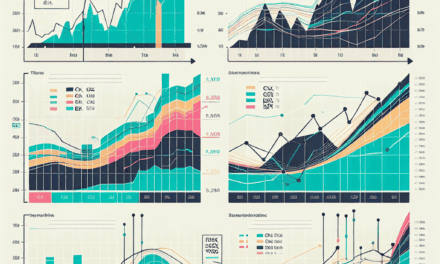“Gold Prices Soar as Interest Rate Hikes Loom on the Horizon.”
Introduction
Gold prices have been on the rise as investors react to shifting expectations surrounding interest rates. With central banks signaling potential changes in monetary policy, market participants are increasingly turning to gold as a safe-haven asset. The interplay between inflation concerns, geopolitical tensions, and the anticipated moves by the Federal Reserve and other central banks has created a favorable environment for gold. As interest rates remain a focal point for economic stability, the allure of gold as a hedge against uncertainty continues to strengthen, driving prices upward.
Gold Prices Surge: Analyzing Interest Rate Trends
In recent months, gold prices have experienced a notable surge, driven primarily by shifting expectations surrounding interest rates. As investors navigate the complexities of the global economy, the interplay between interest rates and gold prices has become increasingly significant. Understanding this relationship is essential for grasping the current dynamics of the precious metals market.
Historically, gold has been viewed as a safe-haven asset, particularly during periods of economic uncertainty. When interest rates are low, the opportunity cost of holding non-yielding assets like gold diminishes, making it a more attractive investment. Conversely, when interest rates rise, the appeal of gold often wanes, as investors may prefer assets that offer higher returns. However, the current economic landscape presents a unique scenario where expectations of interest rate movements are influencing gold prices in unexpected ways.
As central banks around the world, particularly the Federal Reserve in the United States, signal potential changes in monetary policy, market participants are closely monitoring these developments. Recent statements from policymakers have suggested a more cautious approach to interest rate hikes, which has led to a reassessment of future monetary policy. This uncertainty has prompted investors to flock to gold as a hedge against potential economic volatility. Consequently, the demand for gold has surged, pushing prices higher.
Moreover, inflationary pressures have also played a crucial role in driving gold prices upward. With rising consumer prices and supply chain disruptions affecting various sectors, many investors are turning to gold as a safeguard against inflation. Unlike fiat currencies, which can be devalued through excessive monetary expansion, gold has historically maintained its value over time. As inflation expectations rise, the allure of gold as a store of value becomes more pronounced, further contributing to its price increase.
In addition to inflation concerns, geopolitical tensions and global uncertainties have added another layer of complexity to the gold market. Events such as trade disputes, political instability, and conflicts can create an environment of fear and uncertainty, prompting investors to seek refuge in gold. This flight to safety often results in increased demand, which, coupled with the aforementioned interest rate dynamics, can lead to significant price movements.
Furthermore, the behavior of institutional investors has also influenced gold prices. As large financial institutions and hedge funds adjust their portfolios in response to changing economic conditions, their buying or selling activities can have a substantial impact on the market. Recent trends indicate that many institutional investors are increasing their allocations to gold, viewing it as a strategic asset in an increasingly uncertain economic environment. This institutional interest not only bolsters demand but also reinforces the perception of gold as a viable investment option.
As we look ahead, the outlook for gold prices will likely remain closely tied to interest rate expectations and broader economic indicators. Should central banks maintain a dovish stance and prioritize economic recovery over aggressive rate hikes, gold may continue to benefit from heightened demand. Conversely, any unexpected shifts towards tighter monetary policy could pose challenges for gold prices. Ultimately, the intricate relationship between interest rates and gold will continue to shape market dynamics, making it essential for investors to stay informed and adaptable in this ever-evolving landscape.
The Impact of Federal Reserve Policies on Gold Prices
The relationship between Federal Reserve policies and gold prices is a complex interplay that reflects broader economic conditions and investor sentiment. As the Federal Reserve adjusts interest rates, it significantly influences the attractiveness of gold as an investment. When the Fed raises interest rates, the opportunity cost of holding non-yielding assets like gold increases, often leading to a decline in gold prices. Conversely, when the Fed signals a pause or a reduction in interest rates, gold typically becomes more appealing, as lower rates diminish the returns on interest-bearing assets, prompting investors to seek refuge in gold.
In recent months, market participants have closely monitored the Fed’s stance on interest rates, particularly in light of inflationary pressures and economic recovery signals. The central bank’s dual mandate of promoting maximum employment and stable prices often leads to nuanced decisions regarding rate adjustments. For instance, if inflation rates rise significantly, the Fed may opt to increase interest rates to curb spending and stabilize prices. This action can lead to an immediate reaction in the gold market, as investors reassess their portfolios in response to the anticipated higher returns from bonds and other fixed-income securities.
Moreover, the Fed’s communication strategy plays a crucial role in shaping market expectations. Forward guidance, which involves signaling future monetary policy intentions, can create volatility in gold prices. If the Fed indicates a hawkish stance, suggesting that rate hikes are imminent, gold prices may experience downward pressure as investors shift their focus to assets that yield interest. On the other hand, dovish signals, which imply a more accommodative monetary policy, can bolster gold prices as investors flock to the metal as a hedge against potential economic uncertainty.
Additionally, geopolitical factors and global economic conditions further complicate the dynamics between Federal Reserve policies and gold prices. For instance, during periods of heightened geopolitical tension or economic instability, gold often serves as a safe-haven asset. In such scenarios, even if the Fed maintains a steady interest rate policy, gold prices may rise due to increased demand from investors seeking to protect their wealth. This phenomenon illustrates that while the Fed’s policies are a significant driver of gold prices, they are not the sole determinant.
Furthermore, the interplay between the U.S. dollar and gold prices cannot be overlooked. Typically, a stronger dollar makes gold more expensive for foreign investors, which can lead to a decrease in demand and subsequently lower prices. Conversely, when the dollar weakens, gold becomes more attractive, often resulting in price increases. The Fed’s interest rate decisions directly impact the strength of the dollar, thereby influencing gold prices. For example, if the Fed adopts a more dovish approach, the dollar may weaken, leading to a surge in gold prices as investors seek to capitalize on the declining currency value.
In conclusion, the impact of Federal Reserve policies on gold prices is multifaceted, shaped by interest rate decisions, market expectations, geopolitical factors, and currency fluctuations. As investors navigate this intricate landscape, they must remain vigilant to the signals emanating from the Fed, as these will continue to play a pivotal role in determining the trajectory of gold prices in the months and years to come. Understanding this relationship is essential for making informed investment decisions in an ever-evolving economic environment.
Safe Haven Assets: Why Investors Turn to Gold
In times of economic uncertainty, investors often seek refuge in safe haven assets, with gold being one of the most prominent choices. The allure of gold as a protective investment stems from its historical significance and intrinsic value, which remain relatively stable compared to other financial instruments. As global markets fluctuate and geopolitical tensions rise, the demand for gold tends to increase, leading to a corresponding rise in its price. This phenomenon is particularly evident in the current economic climate, where expectations surrounding interest rates are influencing investor behavior.
When central banks signal potential changes in interest rates, the implications for various asset classes become pronounced. Typically, lower interest rates make borrowing cheaper, which can stimulate economic growth. However, when rates are expected to rise, the cost of borrowing increases, potentially slowing down economic activity. In such scenarios, investors often pivot towards gold, viewing it as a hedge against inflation and currency devaluation. Unlike fiat currencies, which can be printed in unlimited quantities, gold is a finite resource, making it a more reliable store of value during turbulent times.
Moreover, gold’s appeal is further enhanced by its lack of counterparty risk. Unlike stocks or bonds, which are subject to the performance of the issuing entity, gold retains its value regardless of the economic conditions affecting other assets. This characteristic becomes particularly attractive when investors are concerned about the stability of financial institutions or the broader economy. As a result, during periods of heightened uncertainty, such as those prompted by geopolitical conflicts or financial crises, gold often experiences a surge in demand, driving prices upward.
Additionally, the psychological aspect of investing in gold cannot be overlooked. The metal has been revered for centuries, symbolizing wealth and security. This historical context contributes to a collective mindset among investors that gold is a safe haven during times of distress. Consequently, as news of potential interest rate hikes circulates, many investors instinctively turn to gold, further fueling its price increase. This behavior creates a self-reinforcing cycle, where rising prices attract more investors, leading to even higher valuations.
Furthermore, the dynamics of supply and demand play a crucial role in the gold market. While demand for gold can spike during periods of economic uncertainty, the supply is relatively inelastic. Gold mining is a capital-intensive process that cannot be rapidly scaled up in response to sudden increases in demand. This mismatch between supply and demand can exacerbate price increases, as investors compete for a limited resource. Consequently, as interest rate expectations shift and economic conditions evolve, the interplay between these factors can lead to significant fluctuations in gold prices.
In conclusion, the current landscape of rising gold prices amid interest rate expectations underscores the metal’s enduring status as a safe haven asset. Investors are drawn to gold not only for its historical significance and intrinsic value but also for its ability to provide stability in uncertain times. As economic conditions continue to evolve, the demand for gold is likely to remain robust, reinforcing its position as a cornerstone of investment strategies aimed at preserving wealth and mitigating risk. Ultimately, the interplay of interest rates, economic stability, and investor psychology will continue to shape the dynamics of the gold market, making it a focal point for those seeking security in their investment portfolios.
Historical Correlation Between Interest Rates and Gold Prices
The relationship between interest rates and gold prices has long been a subject of interest for economists and investors alike. Historically, gold has been viewed as a safe-haven asset, particularly during periods of economic uncertainty or inflation. As interest rates fluctuate, they can significantly influence the demand for gold, thereby affecting its market price. Understanding this correlation requires a closer examination of the underlying economic principles that govern both interest rates and the value of gold.
When interest rates rise, the opportunity cost of holding non-yielding assets like gold increases. Investors tend to favor interest-bearing assets, such as bonds or savings accounts, which offer returns that can outpace inflation. Consequently, higher interest rates often lead to a decline in gold prices, as investors shift their capital towards more lucrative investments. This trend can be observed in various historical contexts, particularly during periods of aggressive monetary tightening by central banks. For instance, during the late 1970s and early 1980s, the U.S. Federal Reserve raised interest rates significantly to combat rampant inflation. As a result, gold prices experienced a notable decline, reflecting the reduced attractiveness of gold as an investment.
Conversely, when interest rates are low or are expected to decrease, gold often becomes more appealing. In such environments, the opportunity cost of holding gold diminishes, as the returns on interest-bearing assets are less attractive. This scenario typically leads to increased demand for gold, driving its price upward. The period following the 2008 financial crisis serves as a prime example of this phenomenon. Central banks around the world slashed interest rates to stimulate economic growth, which in turn led to a surge in gold prices. Investors sought refuge in gold as a hedge against potential inflation and currency devaluation, resulting in a significant rally in the precious metal’s value.
Moreover, the interplay between inflation expectations and interest rates further complicates the relationship between gold prices and monetary policy. When inflation is anticipated to rise, central banks may be prompted to increase interest rates to maintain price stability. However, if inflation outpaces interest rate hikes, the real return on interest-bearing assets can turn negative, making gold a more attractive option. This dynamic was evident in the years leading up to the COVID-19 pandemic, where low interest rates combined with rising inflation expectations contributed to a robust increase in gold prices.
In addition to these economic factors, geopolitical events and market sentiment also play crucial roles in shaping the correlation between interest rates and gold prices. During times of political instability or global uncertainty, investors often flock to gold as a safe haven, regardless of prevailing interest rates. This behavior underscores the multifaceted nature of gold as an asset class, where psychological factors can sometimes overshadow traditional economic indicators.
In conclusion, the historical correlation between interest rates and gold prices is complex and influenced by a myriad of factors, including opportunity costs, inflation expectations, and geopolitical events. As interest rates continue to fluctuate in response to changing economic conditions, understanding this relationship becomes increasingly important for investors seeking to navigate the intricacies of the financial markets. By recognizing the historical patterns and current trends, investors can make more informed decisions regarding their gold investments, ultimately enhancing their portfolio’s resilience in an ever-evolving economic landscape.
Global Economic Factors Influencing Gold Price Increases
In recent months, gold prices have experienced a notable increase, largely driven by a complex interplay of global economic factors. One of the primary influences on the rising value of gold is the prevailing sentiment surrounding interest rates. As central banks, particularly the Federal Reserve in the United States, signal potential shifts in monetary policy, investors often turn to gold as a safe haven asset. This behavior is rooted in the historical context of gold’s performance during periods of economic uncertainty, where it has consistently served as a hedge against inflation and currency devaluation.
Moreover, the anticipation of interest rate changes can lead to fluctuations in the value of the U.S. dollar. When interest rates are expected to rise, the dollar typically strengthens, which can exert downward pressure on gold prices. Conversely, when rates are projected to remain low or decrease, the dollar may weaken, making gold more attractive to investors. This inverse relationship underscores the importance of interest rate expectations in shaping market dynamics. As investors digest economic indicators and central bank communications, their reactions can create significant volatility in gold prices.
In addition to interest rates, geopolitical tensions and global economic stability play crucial roles in influencing gold prices. For instance, ongoing conflicts, trade disputes, and political instability can lead to increased demand for gold as a protective asset. Investors often seek refuge in gold during times of uncertainty, driving up its price. Recent events, such as tensions in Eastern Europe and trade negotiations between major economies, have heightened concerns about global stability, prompting a surge in gold purchases. This behavior reflects a broader trend where investors prioritize security over potential returns, particularly in unpredictable environments.
Furthermore, inflationary pressures are another critical factor contributing to the rise in gold prices. As central banks implement expansive monetary policies to stimulate economic growth, concerns about rising inflation become more pronounced. When inflation expectations increase, the purchasing power of fiat currencies diminishes, leading investors to seek assets that can preserve value. Gold, with its intrinsic value and historical role as a store of wealth, becomes an appealing option in such scenarios. The correlation between inflation rates and gold prices is well-documented, as rising inflation often results in increased demand for gold, further driving up its market value.
Additionally, the performance of global equity markets can influence gold prices. When stock markets experience volatility or downturns, investors may pivot towards gold as a more stable investment. This shift is particularly evident during periods of economic downturns or corrections in equity markets, where the allure of gold as a non-correlated asset becomes more pronounced. The recent fluctuations in stock indices have prompted many investors to reassess their portfolios, leading to a greater allocation towards gold and contributing to its price increase.
In conclusion, the recent climb in gold prices can be attributed to a confluence of global economic factors, including interest rate expectations, geopolitical tensions, inflationary pressures, and the performance of equity markets. As these elements continue to evolve, they will undoubtedly shape the trajectory of gold prices in the future. Investors must remain vigilant and informed, as the dynamics influencing gold are complex and multifaceted, reflecting broader trends in the global economy.
Strategies for Investing in Gold During Rate Hikes
As gold prices continue to climb amid shifting interest rate expectations, investors are increasingly considering strategies to navigate this dynamic market. The relationship between interest rates and gold prices is complex; typically, rising interest rates can lead to a stronger dollar and reduced appeal for non-yielding assets like gold. However, in certain economic contexts, gold can serve as a hedge against inflation and currency fluctuations, making it an attractive investment option even during periods of rate hikes. Therefore, understanding effective strategies for investing in gold during these times is crucial for both seasoned and novice investors.
One of the primary strategies involves diversifying one’s portfolio to include gold as a means of risk management. By allocating a portion of investments to gold, individuals can mitigate potential losses from other asset classes that may be adversely affected by rising interest rates. This diversification not only helps in balancing risk but also positions investors to benefit from gold’s historical tendency to retain value during economic uncertainty. Consequently, a well-rounded investment strategy that incorporates gold can provide a buffer against market volatility.
In addition to diversification, investors should consider the timing of their gold purchases. While it may be tempting to buy gold when prices are rising, it is essential to analyze market trends and economic indicators. For instance, if interest rates are expected to rise significantly, it may be prudent to wait for a potential dip in gold prices before making a purchase. Conversely, if inflationary pressures are mounting, investing in gold sooner rather than later could be advantageous. Therefore, staying informed about economic forecasts and market sentiment is vital for making timely investment decisions.
Another effective strategy is to explore various forms of gold investment. While many investors gravitate towards physical gold, such as coins and bullion, there are alternative avenues worth considering. Gold exchange-traded funds (ETFs) offer a convenient way to gain exposure to gold without the need for physical storage. These funds typically track the price of gold and can be traded like stocks, providing liquidity and ease of access. Additionally, gold mining stocks can also be a viable option, as they may offer leveraged exposure to gold prices. However, it is important to conduct thorough research on the mining companies and their operational efficiencies, as these factors can significantly impact stock performance.
Moreover, investors should remain vigilant about global economic developments that could influence gold prices. Geopolitical tensions, changes in monetary policy, and shifts in consumer demand can all play a role in driving gold prices higher or lower. By keeping abreast of these factors, investors can make informed decisions about when to enter or exit the gold market. Furthermore, utilizing technical analysis can provide insights into price trends and potential support or resistance levels, aiding in the timing of trades.
Ultimately, investing in gold during periods of rising interest rates requires a thoughtful approach that balances risk and opportunity. By diversifying portfolios, timing purchases wisely, exploring various investment forms, and staying informed about global economic conditions, investors can position themselves to capitalize on the potential benefits of gold as a safe-haven asset. As the economic landscape continues to evolve, those who adopt these strategies may find themselves better equipped to navigate the complexities of the gold market and achieve their investment objectives.
Future Predictions: Gold Prices and Interest Rate Expectations
As global economic conditions continue to evolve, the interplay between gold prices and interest rate expectations remains a focal point for investors and analysts alike. Historically, gold has been viewed as a safe-haven asset, particularly during periods of economic uncertainty or inflationary pressures. In recent months, the anticipation surrounding interest rate adjustments by central banks has significantly influenced market dynamics, leading to fluctuations in gold prices. As we look to the future, understanding the relationship between these two factors is crucial for making informed investment decisions.
The Federal Reserve’s monetary policy decisions are often at the forefront of discussions regarding interest rates. When the Fed signals a potential increase in interest rates, it typically leads to a stronger U.S. dollar, which can exert downward pressure on gold prices. Conversely, when interest rates are expected to remain low or decrease, gold often benefits from increased demand as investors seek alternatives to yield-bearing assets. This inverse relationship highlights the importance of monitoring central bank communications and economic indicators that may signal shifts in interest rate policy.
In the current economic landscape, inflationary concerns have prompted many analysts to predict that central banks may adopt a more cautious approach to interest rate hikes. With inflation rates remaining elevated in various regions, including the United States and Europe, the pressure on central banks to act decisively is palpable. However, the potential for economic slowdown complicates the decision-making process. If central banks prioritize economic growth over curbing inflation, we may see a prolonged period of low interest rates, which could bolster gold prices as investors flock to the asset for its perceived stability.
Moreover, geopolitical tensions and uncertainties surrounding global trade continue to play a significant role in shaping investor sentiment. As conflicts arise and diplomatic relations fluctuate, gold often emerges as a preferred asset for risk-averse investors. The ongoing war in Ukraine, for instance, has heightened concerns about energy prices and supply chain disruptions, leading to increased demand for gold as a hedge against uncertainty. In this context, the interplay between geopolitical events and interest rate expectations becomes even more pronounced, as investors weigh the potential impacts on both economic stability and asset performance.
Looking ahead, many experts suggest that gold prices may continue to climb if interest rates remain low or if the Fed signals a more dovish stance in response to economic challenges. Additionally, the potential for further stimulus measures or quantitative easing could further enhance gold’s appeal as a non-yielding asset. As central banks navigate the complexities of inflation and growth, the decisions they make will undoubtedly influence market sentiment and, consequently, gold prices.
In conclusion, the future trajectory of gold prices is intricately linked to interest rate expectations and broader economic conditions. As investors remain vigilant in monitoring central bank policies and global events, the demand for gold as a safe-haven asset is likely to persist. While uncertainties abound, the historical resilience of gold in times of economic turmoil suggests that it will continue to play a vital role in investment portfolios. Ultimately, understanding the nuances of this relationship will be essential for those looking to navigate the evolving landscape of financial markets in the coming months.
Q&A
1. **Question:** Why are gold prices climbing amid interest rate expectations?
**Answer:** Gold prices are climbing as investors seek a safe haven due to anticipated economic uncertainty and potential inflation, which often leads to increased demand for gold.
2. **Question:** How do interest rate expectations affect gold prices?
**Answer:** When interest rates are expected to remain low or decrease, the opportunity cost of holding gold decreases, making it more attractive compared to interest-bearing assets.
3. **Question:** What role does inflation play in gold price movements?
**Answer:** Rising inflation erodes the purchasing power of currency, prompting investors to buy gold as a hedge against inflation, which can drive up its price.
4. **Question:** Are there specific economic indicators that influence gold prices?
**Answer:** Yes, indicators such as consumer price index (CPI), employment rates, and central bank policies significantly influence gold prices by shaping interest rate expectations.
5. **Question:** How do geopolitical tensions impact gold prices?
**Answer:** Geopolitical tensions often lead to increased market volatility, prompting investors to flock to gold as a safe-haven asset, thereby driving up its price.
6. **Question:** What is the relationship between the U.S. dollar and gold prices?
**Answer:** Gold prices typically have an inverse relationship with the U.S. dollar; when the dollar weakens, gold becomes cheaper for foreign investors, increasing demand and driving up prices.
7. **Question:** How do central bank policies affect gold prices?
**Answer:** Central banks’ decisions on interest rates and monetary policy can influence gold prices; for instance, accommodative policies that keep rates low tend to support higher gold prices.
Conclusion
Gold prices have risen due to increasing expectations of interest rate cuts, as investors seek safe-haven assets amid economic uncertainty. This trend reflects a shift in market sentiment, with gold being viewed as a hedge against inflation and currency fluctuations. As central banks signal potential easing of monetary policy, demand for gold is likely to remain strong, supporting its price in the near term.





